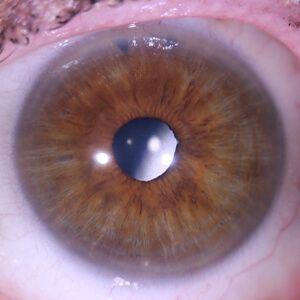Liver Iridology Signs
When you see liver markers, you need to ask your client liver-relevant questions.
by Judith Cobb, MH, CI3, NCP, NNCP, CCII3
DISCLAIMER
This article is not meant to diagnose nor prescribe. It is meant for educational purposes only. Judith Cobb, Cobblestone Health, and Nature's Sunshine Products accept no responsibility for results you get, whether good or bad, from using this information. Always seek the guidance of a qualified health professional.
There are liver iridology signs that tell us about the genetic strength of the liver. There are also markings in the sclera that give us clues that the liver is not happy right now. Just because someone has the genetic potential to have liver issues does not mean problems will arise. If that person eats and drinks healthfully, takes care of their emotions, and makes choices that are protective of the liver, there is a distinct possibility that he can, at the very least, minimize problems and potentially stave problems off entirely. For more information about liver function and support, visit ::[Link coming: 11-Common-Symptoms-That-Say-Your-Liver-Is-Not-Happy].
The sclerae show us how he doing in his efforts. As the liver starts to struggle, potentially before the problems are developed enough to be obvious, there will likely be changes in his sclerae.
We never, ever, use iridology to diagnose (name a disease) or prescribe (give a remedy to heal a disease). We always use it to assess strengths, weaknesses, and imbalances. As we understand these things, we can draw on our herbal, nutritional, and other holistic training to teach our clients how to create a better balance. At times we may need to use the information gathered to refer our clients to seek medical attention.
When you see liver markers, you need to ask your client liver-relevant questions.
Two Liver Iridology Signs
At first glance these signs may look the same; however, one is more likely genetic, and the other is more likely acquired.
1) Brown or Rust-Colored Pigment In the Iris
 When brown or rust-colored pigment is present in an iris, anywhere in an iris, it is an indication that the liver is genetically programmed to have issues. Whether those issues arise is largely reliant on diet and lifestyle.
When brown or rust-colored pigment is present in an iris, anywhere in an iris, it is an indication that the liver is genetically programmed to have issues. Whether those issues arise is largely reliant on diet and lifestyle.
When a ‘liver’ pigment in is a liver reaction zone in the iris, that pigment is called topostabile. Topostabile pigments are doubly significant. They count as two indicators (color and placement) pointing to one potential issue. Ask the liver-relevant questions.
2) Brown Pigment In the Sclera
People who have dark brown (hematogenic) eyes have so much of the pigment, melanin, in their irides that some of it can spill off into the adjacent sclera. This is totally normal, but when melanin accumulates in the sclera at a distance from the pupil it suggests liver imbalances.
People who do not have true brown eyes, but who have hazel or blue eyes (this includes eyes that appear green) have much less melanin. When they have brown pigment in their irides it is an indication of liver imbalances. If that pigment has spilled onto the sclera immediately adjacent to a liver reaction zone it suggests significant liver imbalances.
These are just two of many indicators that suggest the potential for, or the existence of, liver imbalances.
Below are links to 1) a short introductory video about this subject, and 2) a longer webinar recording.


Copyright © 2018 by Judith Cobb, Cobblestone Health Ltd. All rights reserved. Please respect the time it takes to write and publish articles. If you will link to this article and give proper attribution, you are encouraged to quote sections (though not the entire article).

